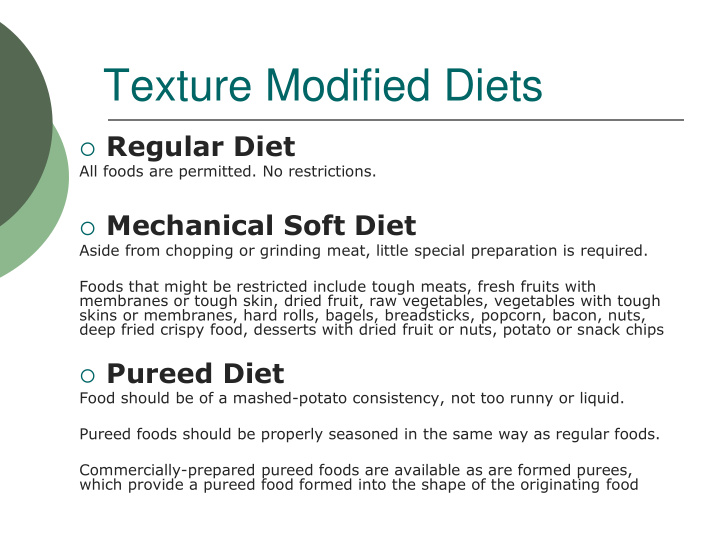



Texture Modified Diets Regular Diet All foods are permitted. No restrictions. Mechanical Soft Diet Aside from chopping or grinding meat, little special preparation is required. Foods that might be restricted include tough meats, fresh fruits with membranes or tough skin, dried fruit, raw vegetables, vegetables with tough skins or membranes, hard rolls, bagels, breadsticks, popcorn, bacon, nuts, deep fried crispy food, desserts with dried fruit or nuts, potato or snack chips Pureed Diet Food should be of a mashed-potato consistency, not too runny or liquid. Pureed foods should be properly seasoned in the same way as regular foods. Commercially-prepared pureed foods are available as are formed purees, which provide a pureed food formed into the shape of the originating food
Thickened Liquids Thin Includes water, coffee, tea, soda, ices, tomato juice or anything else that will quickly liquefy in the mouth. For those who can drink thin liquids, all beverages are acceptable. Nectar-like Liquids that have been thickened to a consistency that coats and drips off a spoon, similar to unset gelatin. Honey-like Liquids that have been thickened to honey consistency. The liquid flows off a spoon in a ribbon, just like actual honey. Spoon-thick Liquids that have been thickened to a pudding consistency. They remain on the spoon in a soft mass. More than likely you are going to see Nectar thickened and Honey thickened beverages.
Therapeutic Diet Orders RCS (Reduced Concentrated Sweets) Renal NAS (No Added Salt) Fluid Restriction
RCS (Reduced Concentrated Sweets) Diet For residents diagnosed with diabetes. In a Long Term Care facility, diabetic diet orders are usually liberalized to maximize meal intake The resident will receive a smaller portion of dessert and sugar substitute packets on their meal tray. For caloric supplementation, Glucerna, or MedPass No Sugar Added are given
Renal Diet For residents with a diagnosis of Chronic Kidney Disease or whose kidneys don’t filter and function normally. Nutrients that must be monitored and possibly restricted are Potassium, Phosphorus, and Sodium Excess amounts of these nutrients can cause heart problems, fluid retention, edema, and bone loss. Foods that might be restricted include: Tomatoes, potatoes, bananas, oranges, beans, processed meats, salt packets, and dairy products
NAS (No Added Salt) Diet Appropriate for residents with moderate hypertension (high blood pressure) or heart disease A regular diet with the exception that no salt may be added to food after preparation No salt packet or shaker is allowed with the patient’s meal
Fluid Restriction An individual might be put on a fluid restriction if they are diagnosed with End Stage Renal Disease, Congested Heart Failure, liver disease, or hyponatremia (low levels of sodium in blood) The amount of fluid allowed will vary based on the patient’s condition and what the physician feels is appropriate for the individual Broth based soups, ice cream, popsicles, gravy, sauces, and Jell-O are all considered fluids. Anything liquid at room temperature. It’s important to check with nursing staff before offering additional fluid to the resident
Recommend
More recommend